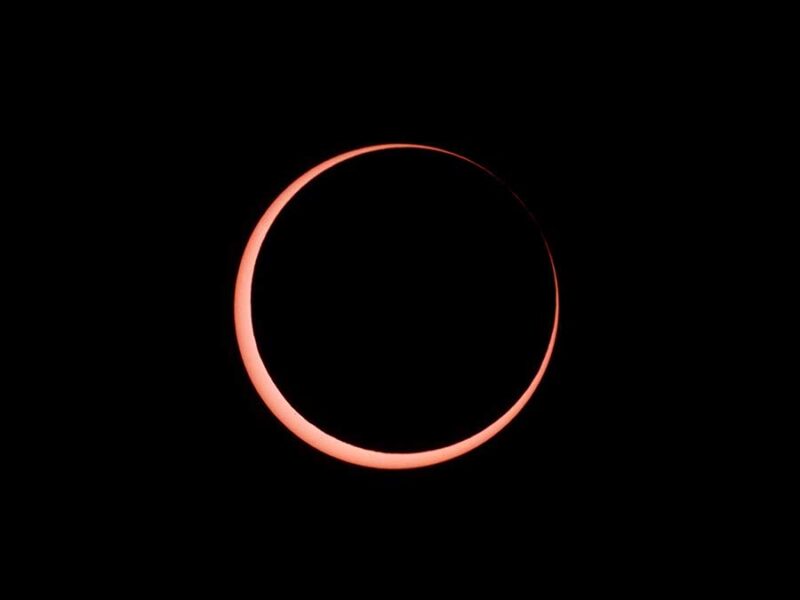
Rick Fienberg / Sky & Telescope
The annular solar eclipse coming to the U.S. on Saturday, October 14th, is popularly known as the “ring of fire.” The main event is the appearance of a ring of light around the Moon, something that results from the Moon being far from Earth, near its monthly apogee, as the Moon crosses the face of the Sun.
That aesthetically pleasing annulus will only be seen from within a path that’s 200 kilometers (125 miles) wide. To see it for the longest time (up to 4 minutes 52 seconds on the Texas coast) the observer will need to be towards the centerline of that path.
However, some eclipse-chasers will purposely miss the ring of fire almost entirely. They’ll travel to the edge of the eclipse path, perhaps seeing a lopsided ring for fleeting moments. They’re there to see a phenomenon more often associated with a total solar eclipse — Baily’s beads.
These beads of light stream between the mountains along the edge the Moon. They are most obvious just prior to and after totality during a total solar eclipse, visible only through a telescope with a solar filter attached. However, they’re also on display — again, only through a telescope equipped with a solar filter — during an annular solar eclipse, when the Moon’s limb appears to touch the edge of the Sun.
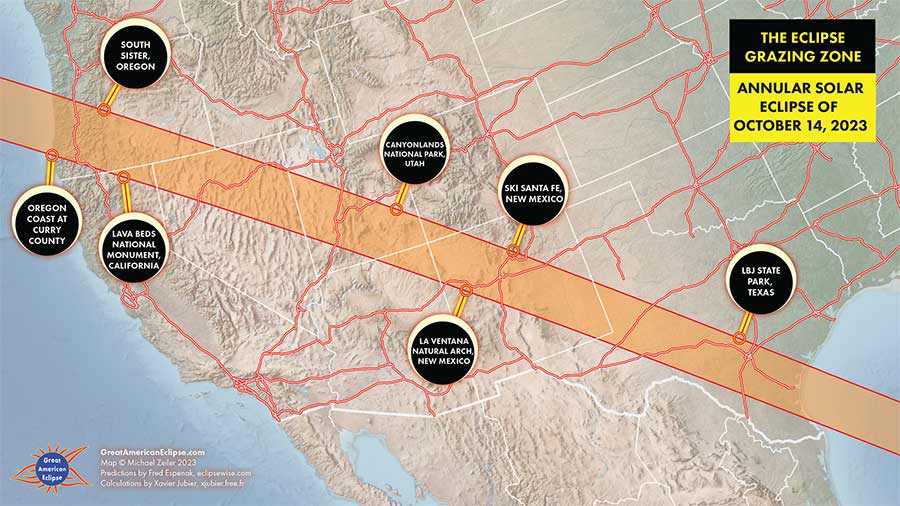
Michael Zeiler / GreatAmericanEclipse.com
“In my case, I don’t believe my chosen location will have any unbroken annulus, but that doesn’t concern me,” says Michael Zeiler, a solar eclipse cartographer who runs GreatAmericanEclipse.com. “I will see the gorgeous sight of an asymmetric ring that will be slightly broken by a very long train of Baily’s Beads — that’s what I want to see.”
It’s possible to see Baily’s beads at the centerline of the path, but only for a few seconds. Only at the edge of the path is it possible to see the beads speed up and slow down for several minutes before and after peak obscuration, respectively. This is the so-called “grazing zone”. While eclipse maps have straight lines representing the edges of a path, it's actually an irregular shape because of the Moon's bumpy terrain. However, high-resolution data from NASA’s Lunar Reconnaissance Orbiter (LRO) is now being used by eclipse cartographers to plot the “grazing zone” on Earth, a region roughly 3 km wide. Here, then, are some suggestions for specialist eclipse-chasers after something other than the sight of a “ring of fire” on October 14th.
The times given are for maximum eclipse, but Baily’s beads will be visible well before that. Be in position 80 minutes before the listed times to see the beginning of the partial solar eclipse.
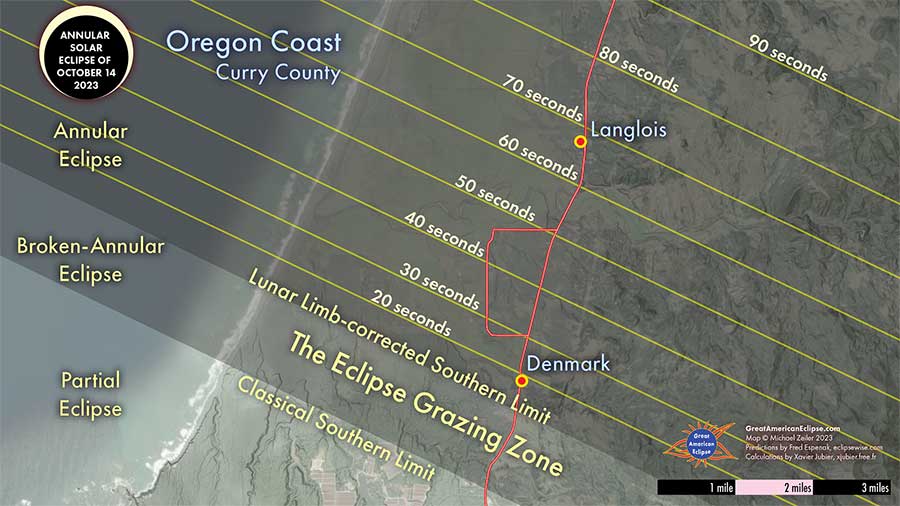
Michael Zeiler / GreatAmericanEclipse.com
1. Oregon Coast (Curry County)
Maximum eclipse: 9:17 a.m. PDT
Location of eclipse in the sky: 17º above southeast horizon.
Northern or southern limit of path: southern
The Oregon Coast will be a popular place with photographers. Just inland is the small town of Denmark in Curry County, which hosts both Floras Lake and the Bandon/Port Orford KOA Journey campsite in the grazing zone.
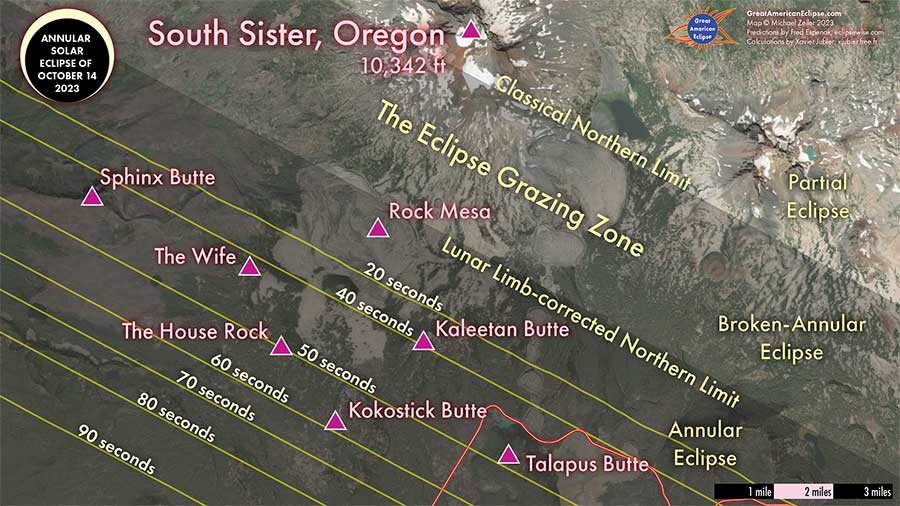
Michael Zeiler / GreatAmericanEclipse.com
2. South Sister, Oregon
Maximum eclipse: 9:19 a.m. PDT
Location of eclipse in the sky: 19º above southeast horizon.
Northern or southern limit of path: northern
Just inside the northern limit is the Three Sisters Wilderness area around a complex volcano. South Sister is just outside the path, but the Moraine Lake Campground is right on the cusp of the grazing zone. Expect great views of South Sister and Broken Top to accompany a broken annulus.
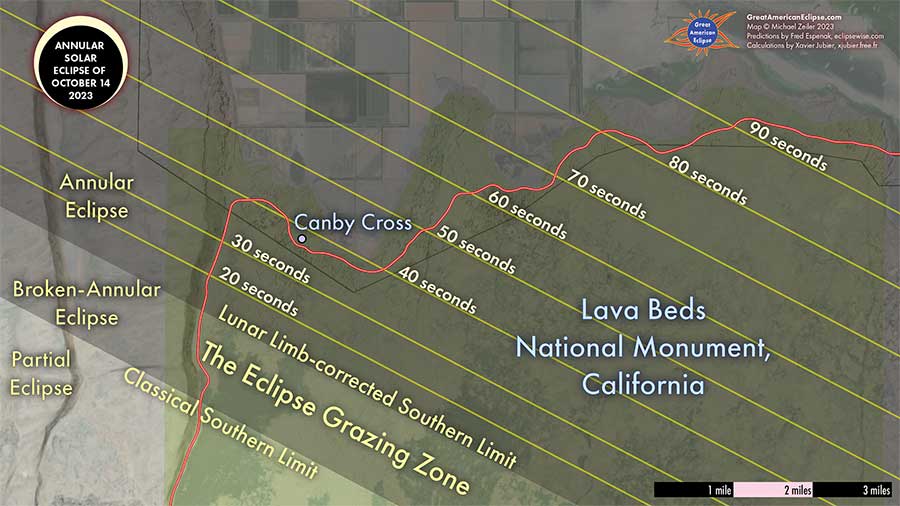
Michael Zeiler / GreatAmericanEclipse.com
3. Lava Beds National Monument, California
Maximum eclipse: 9:19 a.m. PDT
Location of eclipse in the sky: 20º above southeast horizon.
Northern or southern limit of path: southern
California’s best place for edge effects will be Lava Beds National Monument on the north face of the Medicine Lake Shield Volcano. A good grazing zone location would be the parking area at Devil's Homestead Overlook, close to Gillem Bluff, which is marked on the official map.
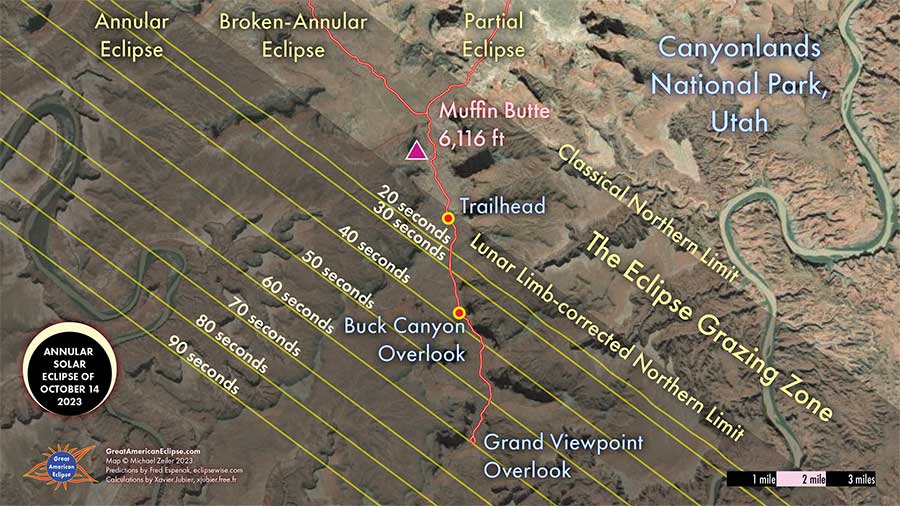
Michael Zeiler / GreatAmericanEclipse.com
4. Canyonlands, Utah
Maximum eclipse: 10:30 a.m. MDT
Location of eclipse in the sky: 31º above southeast horizon.
Northern or southern limit of path: northern
Perhaps the most famous sight of all in Canyonlands National Park, Mesa Arch, is outside the eclipse path. However, just past it going south are two locations ideal for seeing a broken annular — Candlestick Tower Overlook and Green River Overlook. The latter has Willow Flat Campground very close by, which has 12 first-come, first-served campsites ($15 per site).
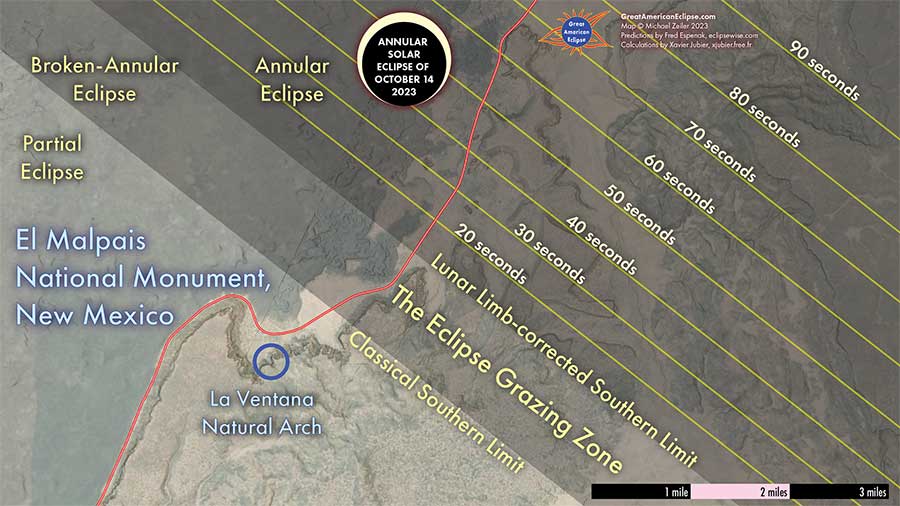
Michael Zeiler / GreatAmericanEclipse.com
5. La Ventana Natural Arch, New Mexico
Maximum eclipse: 10:35 a.m. MDT
Location of eclipse in the sky: 35º above southeast horizon.
Northern or southern limit of path: southern
The volcanic landscapes of El Malpais National Monument are just outside the path, but the 3 km region between the La Ventana Natural Arch Trailhead and Zuni-Acoma Trailhead crosses through the grazing zone, with the latter area enjoying a short ring of fire.
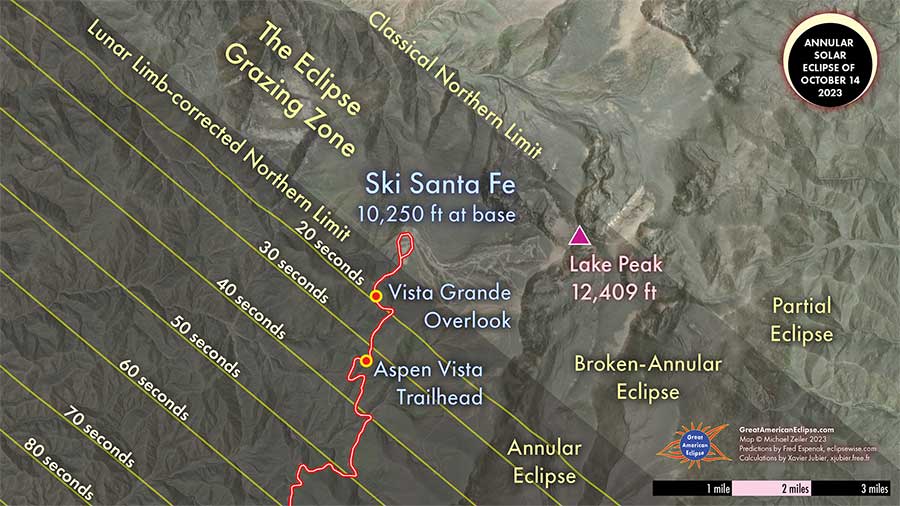
Michael Zeiler / GreatAmericanEclipse.com
6. Ski Santa Fe, New Mexico
Maximum eclipse: 10:37 a.m. MDT
Location of eclipse in the sky: 36º above southeast horizon.
Northern or southern limit of path: northern
A great place for observing “edge effects” will be Ski Santa Fe, which has a parking lot firmly in the grazing zone. For a 20-second view of the annular, stop just short of the top at Vista Grande Overlook.
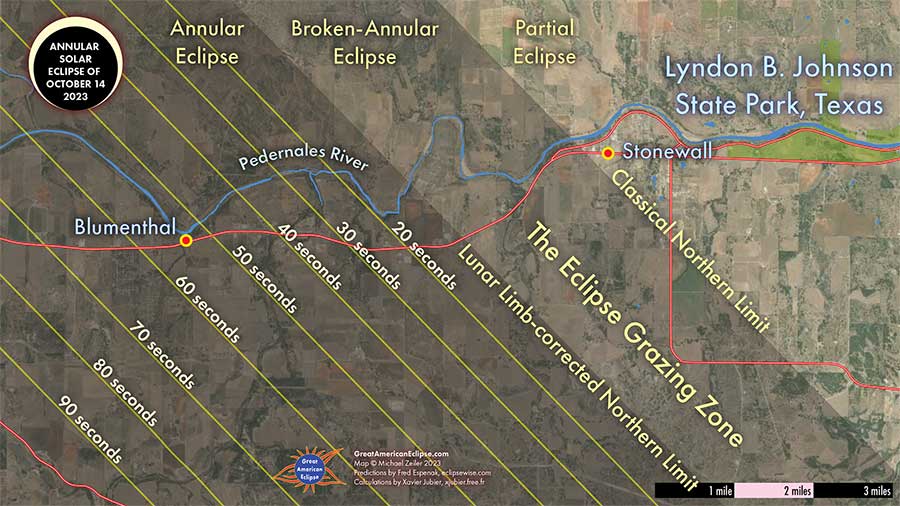
Michael Zeiler / GreatAmericanEclipse.com
7. Lyndon B. Johnson State Park, Texas
Maximum eclipse: 11:52 a.m. CDT
Location of eclipse in the sky: 46º above southeast horizon.
Northern or southern limit of path: northern
Lyndon B. Johnson State Park & Historic Site in Texas is just outside the northern limit of the path, but drive southwest on Highway 290 and you can see extended Baily’s beads and a broken annular ring anywhere along the 3 km line between the west side of Stonewall and Hilmy Cellars. If you have a taste for vineyards, there’s more to see nearby: On the way, adjacent to the Pedernales River, you’ll pass Arrowhead Creek Vineyard and Rhinory, as well as Guadalupe Cemetery. Bluemont Vineyard & Brewery is also in the grazing zone.
 11
11









Comments
astromaster
September 18, 2023 at 1:34 pm
I am concerned that this article contains little information about the actual astronomy to be discussed in such an event. Readers should know that when they go to the northern limit of an Annular Eclipse, then they are observing Baily's Bead events at the southern limb of the Moon. If they observe at the southern limit of an Annular Eclipse, then they are observing Baily's Bead events at the northern limb of the Moon. In all the discussion of the wonderful Earthly views to see, it seems the writer forgot about the Lunar views that await!!!
You must be logged in to post a comment.
Monica Young
September 20, 2023 at 10:10 am
We've posted one general article about observing the annular eclipse here: https://skyandtelescope.org/astronomy-news/observing-octobers-annular-eclipse/ and we'll have more specifics on observing Baily's Beads to come. Stay tuned!
You must be logged in to post a comment.
astromaster
September 21, 2023 at 7:34 pm
Monica, I have always enjoyed your articles! You would know that an observation that requires a high level of precision should receive that kind of attention. Neither this article nor the more general article you mention give the needed discussion of the Celestial Mechanics needed for observers to position themselves accurately for quality observations!
You must be logged in to post a comment.
Yaron Sheffer
September 19, 2023 at 1:20 pm
"Here's where you *should* head" on eclipse day is belittling the entire event. Why send all would be observers to 7 specific locations, when the exact same LUNAR vistas are offered along the entire 2,000 miles length of eclipse path? Indeed, that's like having thousands upon thousands of locations available to all. Besides, why travel to all the way to Denmark, when we have such a great view here from the USA? 😉
You must be logged in to post a comment.
Randy Pfeiffer
September 23, 2023 at 10:43 am
So many ads! It isn't possible to hang around your site and enjoy the information any more. This monetizing of web information sucks in general, but S&T is scraping the bottom of the barrel for funds.
You must be logged in to post a comment.
Andrew James
September 24, 2023 at 4:57 am
Readers hear of this article might like to read my webpage and discussion on observing near the eclipse boundaries. I have seen two annual solar eclipses in Tasmania in 1981 and 1991, and to total solar eclipse near the eclipse limits. The eclipse in 1981 why is from Mount Wellington in Tasmania, Australia, in the early morning just after sunrise. I was placed about 1.5 km outside the predicted eclipse boundary and that was not my choice due to difficult weather conditions. I was involved in the USNO experiment to find the diameter of the sun using timing beads against the Watt's profile. The results identified more than 100 events of which 96 corresponded to the valleys seen in the profile. If you're after excitement at this coming annular eclipse I can recommend what you're reading in this article is something different. You can read a bit more about what you experience on my webpage at http://southastrodel.com/PageEclipses005.htm . Few amateurs or professionals have been brave enough to attempt such kinds of observations, and I don't know anyone who has been within only 180 metres from the eclipse limits deliberately.
The greatest thrill that I've ever experienced was during middle of an eight-second long solar eclipse and even visually seeing the pink chromosphere with minute slithers of light defining the true solar surface!
You must be logged in to post a comment.
astromaster
September 25, 2023 at 9:18 pm
Andrew James, this is the reason I started this discussion. There are many of us who have enjoyed setting up for the challenge of the Limit Line rather than the lack of action found at the Center Line. You can see some of our results at: https://www.asteroidoccultation.com/observations/YouTubeVideos.htm
You must be logged in to post a comment.
Andrew James
September 26, 2023 at 1:50 am
See 'Solar radius variations determined from eight solar eclipses, 1715 - 1984.' https://ui.adsabs.harvard.edu/search/q=author:%22Fiala%2C+A.+D.%22&sort=date%20desc,%20bibcode%20desc
You must be logged in to post a comment.
Andrew James
September 26, 2023 at 1:54 am
I think the first attempts at an annular TS were in 1981 by Alan Fiola See 'Annular Solar Eclipse Observed for Solar Radius Determination.' https://ui.adsabs.harvard.edu/abs/1981BAAS...13..552F/abstract
You must be logged in to post a comment.
Andrew James
September 26, 2023 at 2:03 am
Note: Here 154 beads were observed on 4-5 Feb., 1981 in Tasmania. I saw 104 of them that were recorded over 13 minutes. My position was just 270 metres outside the classic eclipse limit.
You must be logged in to post a comment.
Andrew James
September 26, 2023 at 9:54 pm
Another place is see Baily’s beads is just south of Cali in Colombia with mid-eclipse at 1:33pm local time and lasting 03 min 40 sec at 62 deg altitude.
The astronomical society Red de Astronomía de Colombia RAC has a fantastic article on this annual eclipse in their free journal here https://rac.net.co/ found under Circulares no. 990 (In Spanish) I believe the Observatorio Astronómico de la Biblioteca Departemal is holding a public event too. [Might make a great S&T article!]
You must be logged in to post a comment.
You must be logged in to post a comment.